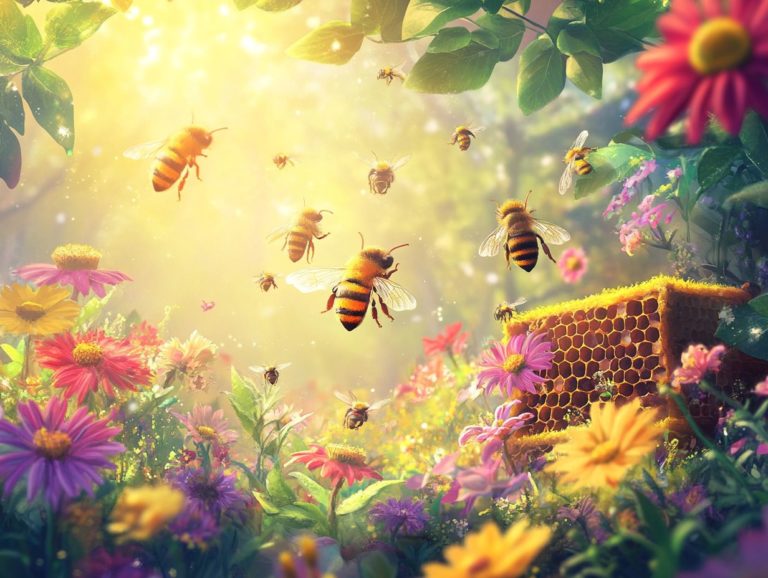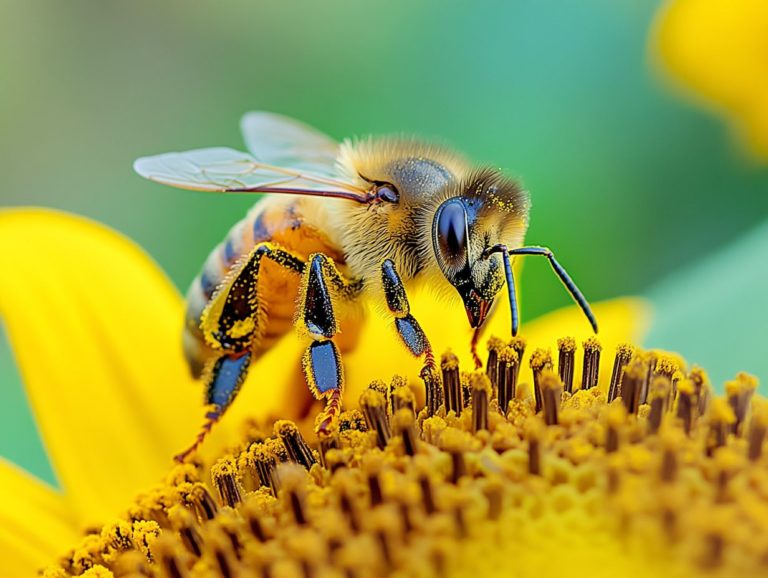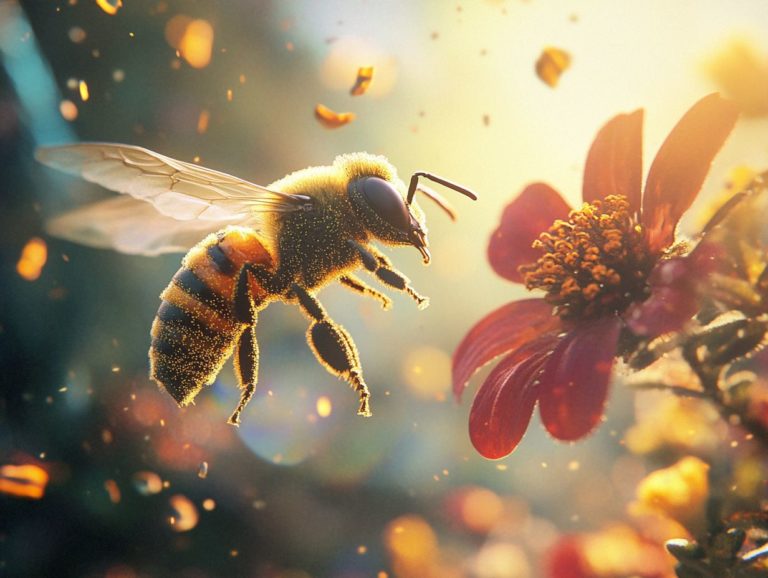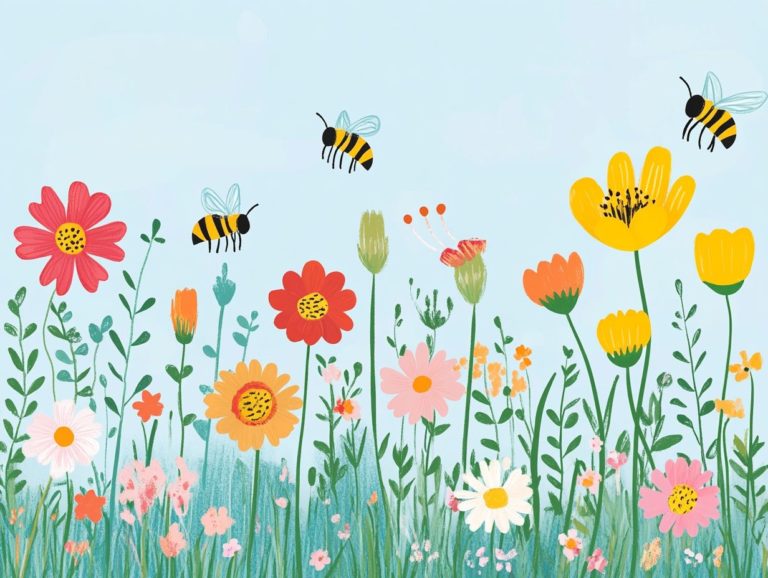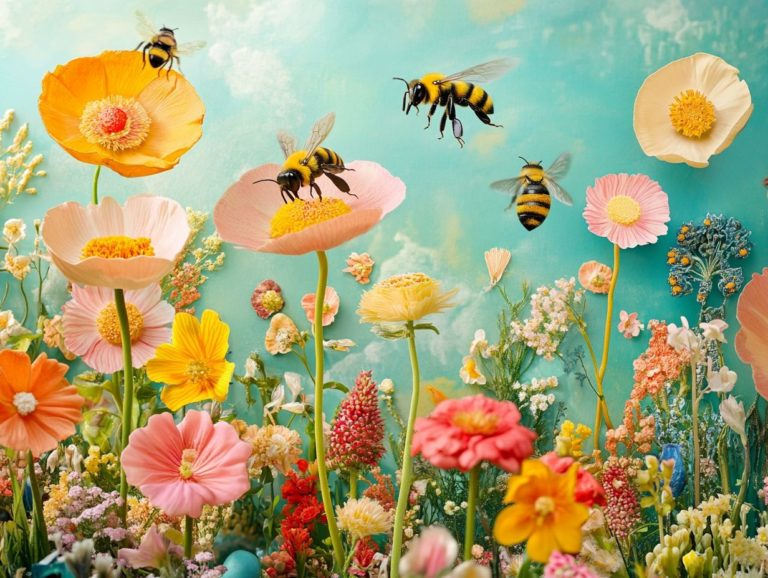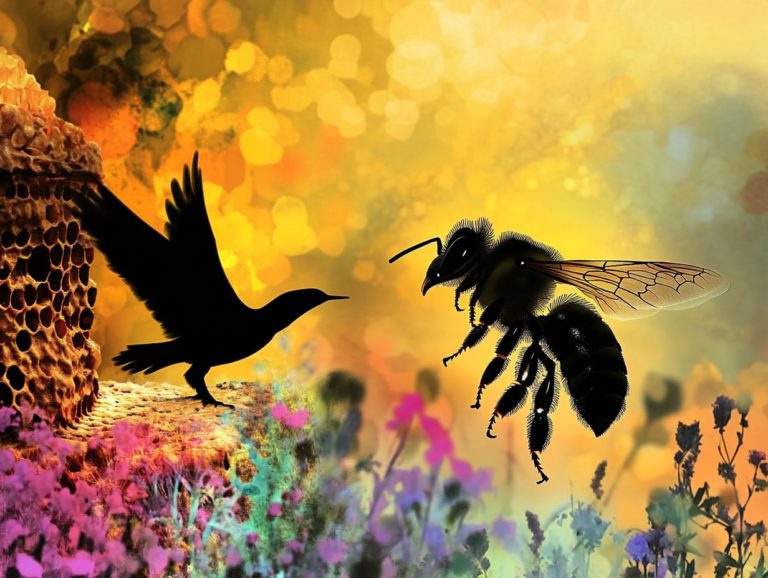How Bees Communicate Through Dance
Honeybees possess a remarkable form of communication that goes beyond mere buzzing. At the heart of their social interaction is the honeybee dance, a unique method through which these diligent insects convey essential information about food sources, such as nectar and pollen, and hive dynamics.
In this exploration, you will delve into the fascinating world of honeybee dances, tracing their discovery and examining various types. You’ll uncover the intricate ways in which bees learn and communicate, including how forager bees pass on crucial information.
These dances not only serve the needs of individual bees but also fortify the entire hive. They play a crucial role in species survival. Dive into the wonders of how bees communicate and why it matters!
Contents
- Key Takeaways:
- What is the Honeybee Dance?
- Types of Honeybee Dances
- How do Bees Learn the Dances?
- The Importance of Honeybee Communication
- Other Forms of Bee Communication
- Sound
- The Fascinating World of Honeybee Communication
- Frequently Asked Questions
- What is the purpose of bees’ dance communication?
- How do bees communicate through dance?
- What are the two main types of dance communication in bees?
- How do bees interpret the information conveyed through dance?
- Do all species of bees use dance communication?
- How do bees learn to perform dance communication?
Key Takeaways:
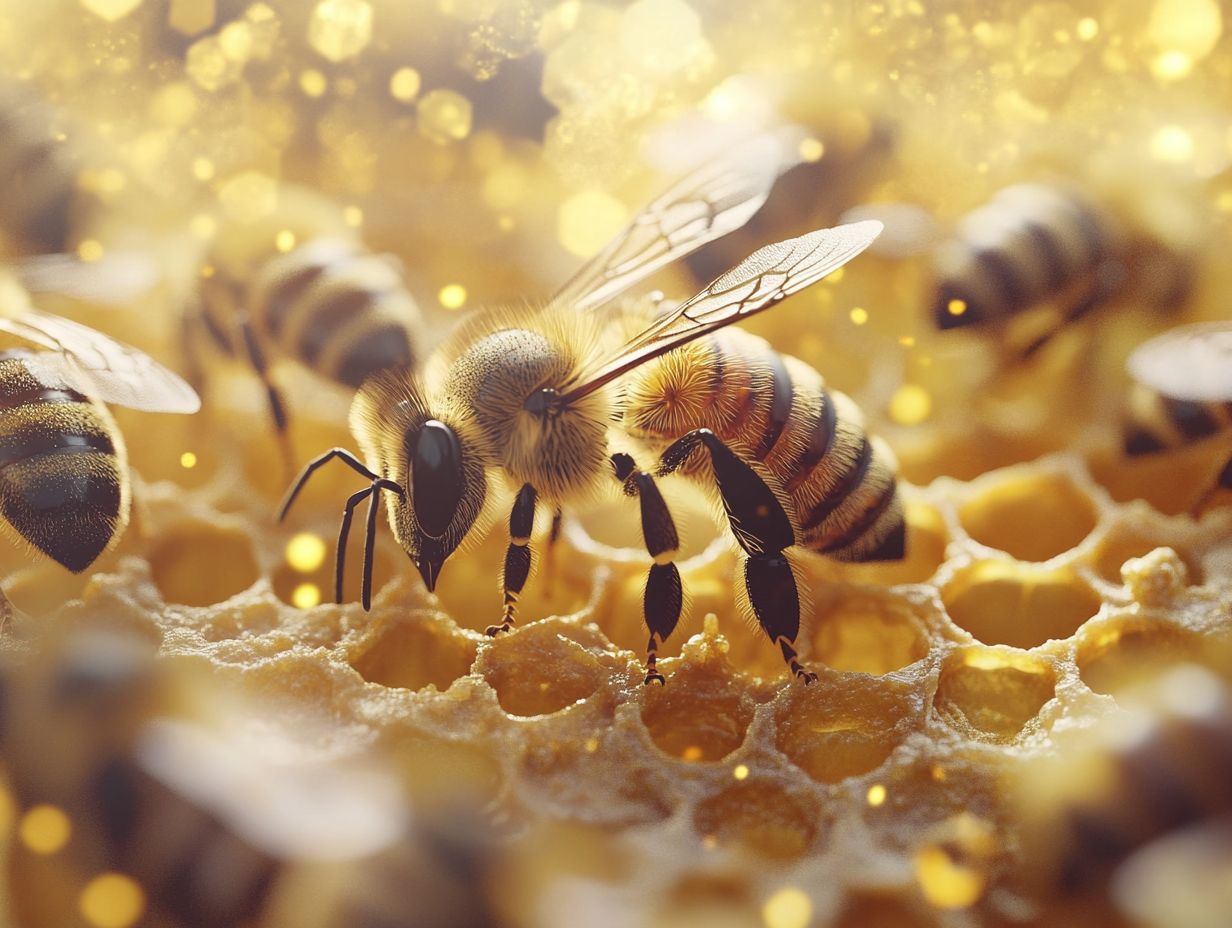
- Honeybees use dance as a form of communication to share information about food sources, direction, and distance with their hive mates, often through distinct movements like waggle runs and return phases.
- The discovery of the honeybee dance was a major breakthrough in understanding bee communication. It continues to fascinate researchers and beekeepers alike.
- The honeybee dance helps the hive function smoothly and plays a crucial role in the survival and success of the entire species.
What is the Honeybee Dance?
The honeybee dance is an extraordinary form of communication. Honey bees, especially the Apis mellifera species, use it to share crucial information about where to find resources like nectar and pollen, often through intricate dance patterns on the hive’s dance floor.
This intricate dance language comprises various movements, including the waggle dance and the round dance. These movements indicate the distance and direction to a flower patch and help the bees survive and work better by mapping out resource locations.
By diving into these dances, you uncover the fascinating complexities of bee behavior and their remarkable social learning processes, including how they interpret electric fields and other environmental cues.
How Was the Honeybee Dance Discovered?
The discovery of the honeybee dance, especially the waggle dance, owes much to the pioneering efforts of ethologist Karl von Frisch. In the 20th century, he dedicated himself to exploring the intricate communication patterns of honey bees, particularly focusing on how they utilize figure-eight patterns for communication.
With a series of groundbreaking experiments, he closely observed how these remarkable insects conveyed critical information about food sources through their distinctive movements. His meticulous analysis unveiled that the angle and duration of the waggle dance held vital clues about the direction and distance to nectar-rich flowers and specific flower species.
This astonishing revelation transformed our understanding of bee behavior. It shed light on their social structures and how they share essential foraging information within the colony. By revealing the intricacies of what might be considered a unique ‘bee dialect,’ von Frisch’s work expanded the scientific community’s perspective on social learning and behavior communication, highlighting the complexity and sophistication of these extraordinary insects’ communication methods.
Types of Honeybee Dances
Honey bees engage in a fascinating array of dances, notably the waggle dance, round dance, and sickle dance. Each serves a unique purpose in their intricate communication and resource-finding efforts, which include flower identification and nectar gathering.
The waggle dance is your bee s way of sharing precise information with fellow colony members about the distance and direction to a nectar-rich flower patch. In contrast, the round dance indicates that food sources are nearby, effectively streamlining the foraging process within the hive.
Through these captivating dances, bees demonstrate their remarkable ability to enhance efficiency and cooperation in their quest for sustenance, effectively mapping out resource locations for optimal foraging.
The Round Dance
The round dance serves as a vital form of communication among honey bees, signaling the presence of nearby nectar sources, typically within a short distance from the hive. This distinctive dance consists of a series of circular movements, accompanied by vibrational signals that convey crucial information.
In contrast to other forms of bee communication, like the waggle dance used for more distant discoveries, the round dance is all about alerting fellow bees to immediate food resources within close range. Bees encourage the tendency of bees to visit the same type of flower repeatedly, which is essential for effective pollination and maximizing resource collection.
This synchronized movement not only underscores the availability of abundant nectar but also fosters social cohesion within the colony, ultimately boosting its survival and efficiency in food gathering.
The Waggle Dance
The waggle dance is a fascinating behavior exhibited by honey bees, serving as their means of communication about the distance and direction of a specific nectar or pollen source from the hive. Picture this: a unique figure-eight pattern that captures the attention of other bees.
As you observe the dance, you’ll notice the bees performing a series of waggling runs followed by sharp turns, which act as vital indicators. The angle of the waggling dance in relation to the vertical comb reveals the direction of the resource concerning the sun s position and flower patterns.
When the bees return to their starting point, they complete the loop and repeat this sequence, reinforcing their message. Other bees watching this intricate performance can decode these movements through their natural instincts and social cues, enabling them to participate effectively in foraging activities.
This extraordinary communication system allows bees to navigate with precision to their desired resources, significantly boosting the efficiency of the hive and ensuring optimal nectar processing and resource mapping.
The Sickle Dance
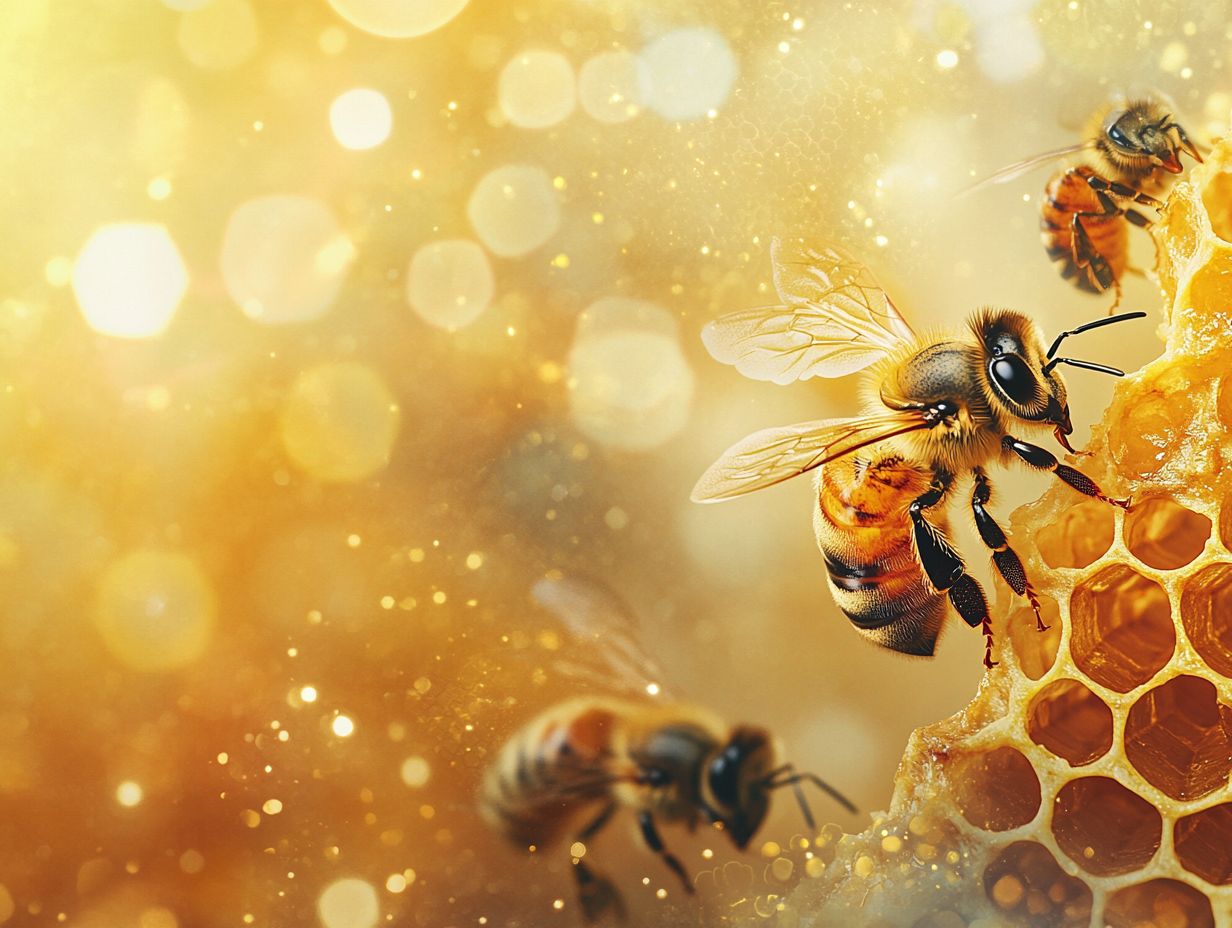
The sickle dance is a rare and captivating way for bees to communicate, especially utilized when bees stumble upon a prime resource and competition is heating up due to the presence of other scouting bees.
This unique dance involves a series of graceful loops and turns, creating a shape reminiscent of a sickle, and it signals to other hive members both the location and desirability of the food source.
When bees engage in the sickle dance, they convey not just the distance and direction to the resource but also its quality, which can significantly influence the foraging behavior of their fellow bees.
During flowering seasons or droughts, bees must quickly adapt to maximize their foraging efforts, tapping into the same resource, thereby boosting the overall efficiency of the colony’s foraging activities and ensuring quality resource collection.
The sickle dance serves as a strategic communication tool and fosters a competitive spirit among bees, ensuring the hive thrives in a constantly shifting environment and enhancing their ability to utilize pheromones for more effective communication.
How do Bees Learn the Dances?
Honey bees master the intricate dance language through a fascinating process of social learning. Experienced bees take the lead, demonstrating their dances to fellow colony members. This dynamic interaction ensures the transmission of essential foraging information, such as nectar and pollen sources, allowing the entire colony to thrive.
What is the Role of the Sun in the Honeybee Dance?
The sun plays an essential role in how bees navigate the world around them, much like it does for honey bees during their impressive waggle dance. By adjusting the angle of their dance in relation to the sun, these industrious insects communicate the direction to valuable resources, which is crucial for their survival.
By harnessing the sun’s position, bees can deftly orient themselves within their environment. As they venture out in search of food, they also tap into ultraviolet light, a type of light that humans can’t see but bees can, allowing them to detect flowers and differentiate between various nectar sources. This remarkable ability lets them find the best flowers quickly, which is crucial for their survival!
Environmental cues such as the scents of flowers and the contours of the landscape enrich their navigation repertoire. By weaving these factors together, bees enhance their communication methods, ensuring they share precise information with their hive mates. This ultimately boosts their overall foraging success and colony survival.
Do Bees Have a ‘Language’?
Honey bees employ a remarkable dance language that acts as a vital communication tool within the colony, enabling forager bees to share essential information about resource locations and the quality of nectar sources.
This intricate form of non-verbal communication not only guides fellow bees to sources of nectar and pollen but also reflects the complex social hierarchy and interdependence found within the hive. Through movements like the waggle dance, a bee conveys both distance and direction, demonstrating how these behaviors are finely calibrated to enhance survival strategies.
Observing how the colony collectively interprets these dances offers you a glimpse into their cooperative nature, highlighting a captivating blend of instinct and learned behavior that underscores the significance of collaboration in their thriving ecosystem. This effectively demonstrates the role of social cues in their communication.
The Importance of Honeybee Communication
Honeybee communication is crucial for the survival and efficiency of the colony. Through effective dances like the waggle dance and round dance, these remarkable creatures successfully gather nectar and map out resources, ensuring their community thrives and maintains high communication efficiency.
How Does the Honeybee Dance Help the Hive?
The honeybee dance is an essential tool, providing a smart way of locating resources. This amazing behavior allows the hive to efficiently gather nectar and pollen from a variety of flower species, ensuring the bee colony’s sustenance and growth.
These amazing movements do much more than just show the way; they communicate vital details about the distance and direction of food sources, optimizing foraging runs by guiding your fellow bees on where to venture at different times. When you perform the waggle dance, you share important information about the quality of the resources you’ve discovered, enabling the colony to focus on the most nutritious options.
This collective intelligence cultivates a well-balanced and healthy hive, enhancing productivity and resilience in challenging environments. As a result, these dances play a significant role in the overall health of the colony, fostering a robust social structure that underpins survival and reproduction. The special dances, such as the waggle dance and round dance, are vital for communicating resource locations.
How Does the Honeybee Dance Benefit the Species?
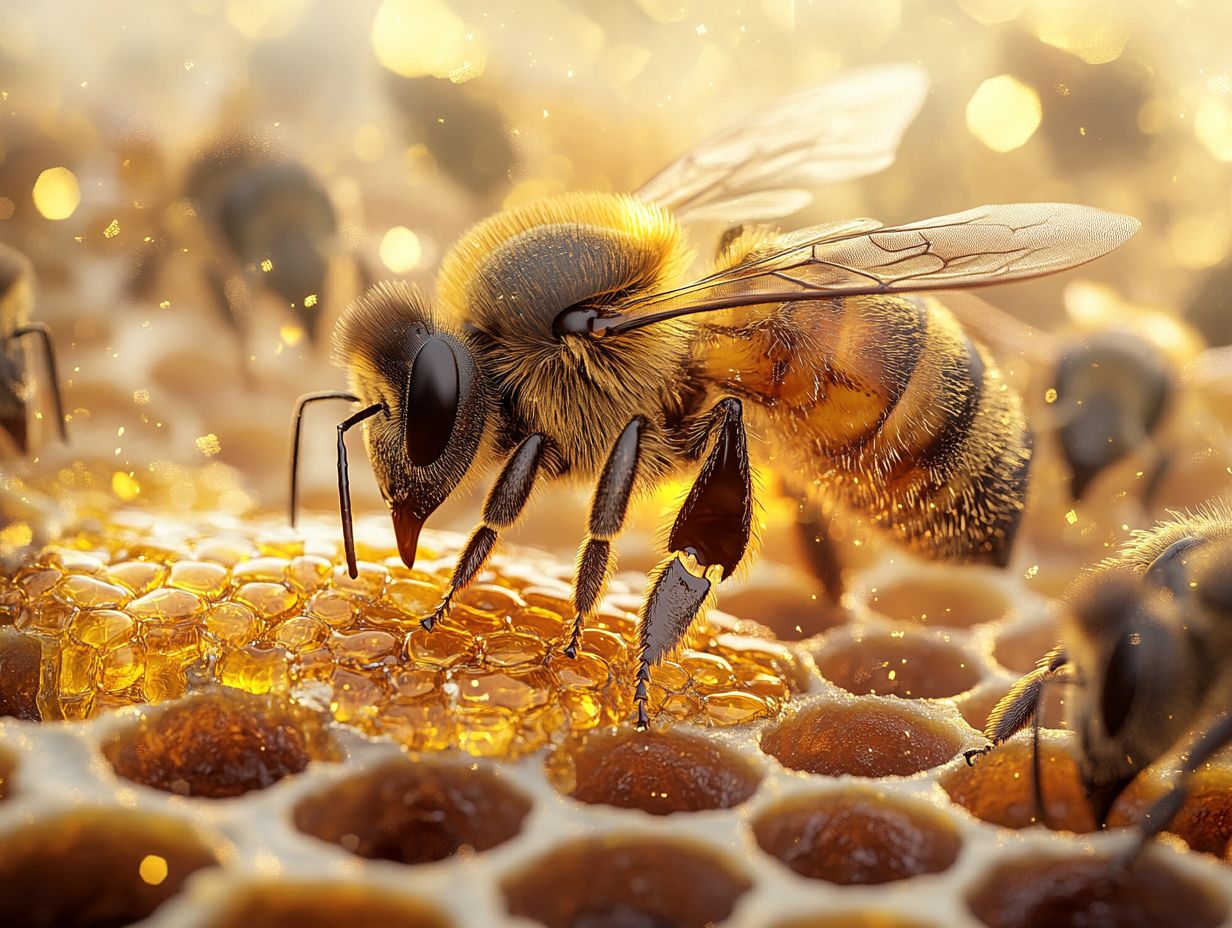
The honeybee dance is not just a quirky little performance; it’s a critical lifeline for individual colonies and the species overall, enhancing foraging efficiency and resource management. Forager bees use these dances to inform the hive about the distance and direction to food resources.
This remarkable form of communication elevates the pollination process and fosters increased biodiversity in the environment. Watch in awe as bees perform their captivating dances, revealing secrets of their behavior and communication! When honeybees convey the location of food sources through their complex movements, they not only boost their own foraging prowess but also play a pivotal role in the health of surrounding ecosystems.
This collective behavior encourages social learning. Younger bees observe and mimic these dances, ensuring that essential knowledge about resource locations is handed down through generations. Such social learning fortifies the resilience of bee populations and secures the vital pollination services that support countless plant species, contributing to the overall ecological balance. The intricate dance patterns and signals exemplify behavior communication within the colony.
Other Forms of Bee Communication
In addition to their remarkable dances, honey bees, such as Apis mellifera and Apis cerana cerana, utilize a rich tapestry of communication methods, including pheromones, tactile signals, and sounds. These intricate means of interaction significantly enhance their capacity to convey vital information and harmoniously coordinate activities within the colony. Communication efficiency in a bee colony is vital for its survival.
Pheromones
Pheromones are fascinating chemical signals that honey bees secrete to convey a range of messages about colony behavior, including alarm signals and the vital presence of their queen. These powerful chemicals are vital for the bee colony’s social structure.
Take, for instance, the queen pheromone. It s crucial for maintaining order and unity within the hive, as it informs the worker bees of her presence and health, effectively suppressing their reproductive capabilities. On the flip side, alarm pheromones activate defensive behaviors, alerting the colony to potential threats from predators or intruders.
Various pheromones mark foraging routes and signal the need for more food resources, shaping how colony members interact and fulfill their designated roles within this remarkable community. These chemical signals are crucial for the overall resource mapping and coordination of the colony.
Touch
Touch is a crucial aspect of communication among honey bees, where physical interactions convey information and reinforce the social bonds within the colony. This sensory modality is essential for a range of activities, from grooming behaviors that promote hygiene to tactile signaling that enhances coordination during foraging.
As you observe bees grooming, you’ll notice that they are not just maintaining their own cleanliness and that of their nest; they are also fostering a sense of community and individual well-being. These interactions are crucial for the hive’s health and productivity, ensuring that the colony not only survives but thrives under various conditions.
These tactile communications significantly boost colony cohesion, allowing bees to share vital information regarding resources and potential threats in their surroundings.
Sound
While often overshadowed by the more flamboyant displays of dancing or the allure of pheromones, sound plays a crucial role in honey bee communication through vibrational signals. These signals convey important messages, whether it s a call to arms in times of alarm, an invitation during mating rituals, or the coordination of hive activities.
These vibrational patterns are essential for communication among bees. For example, when danger lurks nearby, bees emit specific warning vibrations that alert their companions to mobilize for defense, effectively orchestrating a collective response.
During mating flights, male bees produce distinctive sounds to attract potential mates, using these auditory cues to maximize their chances of successful reproduction. The interplay of these sounds alongside other communication methods highlights the complexity of interactions within the hive, showcasing the remarkable adaptability and social structure of these extraordinary insects.
The Fascinating World of Honeybee Communication
The captivating realm of honeybee communication reveals a remarkable tapestry of behaviors. This includes the intricate waggle and round dances, the subtle yet powerful use of pheromones, and the significant influence of social learning among the hive s members.
These diverse methods of communication are essential for the daily operations and overall survival of the colony. For instance, the waggle dance serves not just to indicate the direction and distance to food sources, but also to engage the bees in a shared experience, thereby strengthening their social bonds. Pheromones can signal alarm or indicate reproductive readiness, shaping the actions of the entire colony.
Together, these sophisticated communication strategies help bees forage effectively and ensure reproductive success while underscoring the importance of collective effort. This collaboration is vital for maintaining their ecological role as essential pollinators across various ecosystems.
Frequently Asked Questions
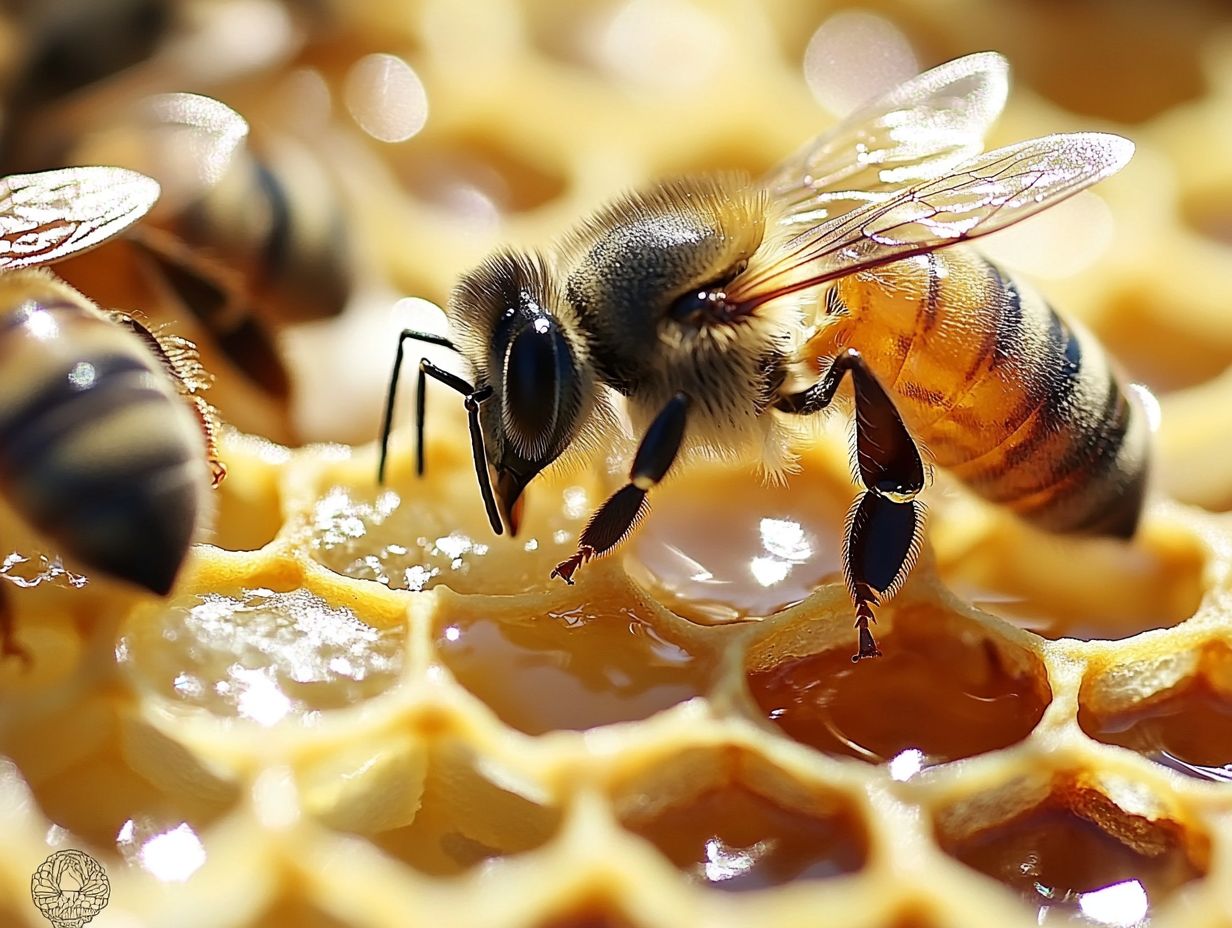
What is the purpose of bees’ dance communication?
The purpose of bees’ dance communication is to inform other bees in the hive about the location, quality, and quantity of a food source.
How do bees communicate through dance?
Bees communicate through dance by performing a series of movements and patterns that convey information about the location of a food source.
What are the two main types of dance communication in bees?
The two main types of dance communication in bees are the waggle dance and the round dance. The waggle dance indicates the direction and distance to a food source, while the round dance signifies food sources that are nearby.
How do bees interpret the information conveyed through dance?
Bees interpret the information conveyed through dance by using their senses, such as vision and smell, to follow the movements and directions of the dancer.
Do all species of bees use dance communication?
No, not all species of bees use dance communication. It is primarily used by honeybees and some species of stingless bees.
How do bees learn to perform dance communication?
Bees learn to perform dance communication through observation and imitation of experienced foragers within the hive. It s fascinating!

